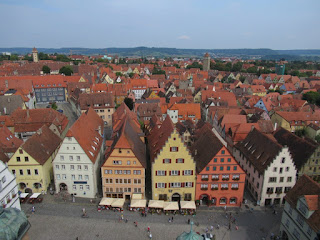I
visited Munich and other places in Bayern (Bavaria).
The
Marienplatz (square) locates in the center of the city. It is surround by the City Hall, middle age-style buildings and modern shops.
The
square is always crowded. Local people as well as foreign tourists gather there.
Political activities are often organized in the square. A meeting organized by Pegida, an
anti-Islam group, was held when I visited there.
Germany
will have a general election on September 24. I saw election posters everywhere throughout the nation, The posters were on
the walls, boards, and poles. The photo
was taken at Bayer’s village Oberammergau.
About 13%, or one in eight, of total population are foreign-born in Germany in 2012, according to OECD data. There are also many second generation of Turkish "guest workers" after the 1960s.
I saw many immigrants from the Middle East in Neuhouser Street, which goes west from the Marienplatz. I found some women wearing burqa.
I saw many immigrants from the Middle East in Neuhouser Street, which goes west from the Marienplatz. I found some women wearing burqa.
I
did not see refugees from Syria in the central part of Munich. Instead, I found a refugee center managed by the local government.
Immigration along with European integration and economic policies is one of the major
issues of the coming election. I wondered what result would be.
The memorial of Dachau Concentration Camp locates in the
suburb of Munich. It was the first and one of several hundreds concentration
camps – the most famous one is Auschwitz, needless to say – built by the Nazi before and during the World War 2.
Dachau camp opened in 1933. Political criminals were first sent into the center. Jews were added. Then, many non-Germans captives, such as Polish and Russians,
were sent here.
They were forced to work in the factories, farms and other places in very bad conditions (like slaves). More than 200,000 prisoners were sent here and about a fourth died.
They were forced to work in the factories, farms and other places in very bad conditions (like slaves). More than 200,000 prisoners were sent here and about a fourth died.
Here
is a monument to console the spirits of the victims. A phrase meaning “never again”
is curved in five languages, Hebrew, French, English, German and Russia. (See the 2nd photo from the top)
Another must-visit place in Munich might be a beer hall. The city hosts the beer festival (October festival) every year and its beer is world-wide famous.
I
enjoyed a glass of beer at famous Hofbrauhaus. The glass was one-letter large. As many as 3000 people can enter the hall. Revolutionist Lenin and other famous historical figures visited here.
Down
to south, I visited the famous Neuschwanstein castle. It was built by Bayern
King Ludwig 2 in the late 19th century (when Bismarck was trying to
unite Germany and to develop a new nation).
(See also the top photo)
The castle was gorgeous.
(See also the top photo)
The castle was gorgeous.
I
also visited Oberammergau, a small summer resort village near the Alps.
The village's residents play a passion play of Jesus Christ regularly (every ten years) and attract millions of visitors from the world. The theater is excellent.
I have enjoyed and learned a lot in my visit to Bayern.
The village's residents play a passion play of Jesus Christ regularly (every ten years) and attract millions of visitors from the world. The theater is excellent.
I have enjoyed and learned a lot in my visit to Bayern.


























































